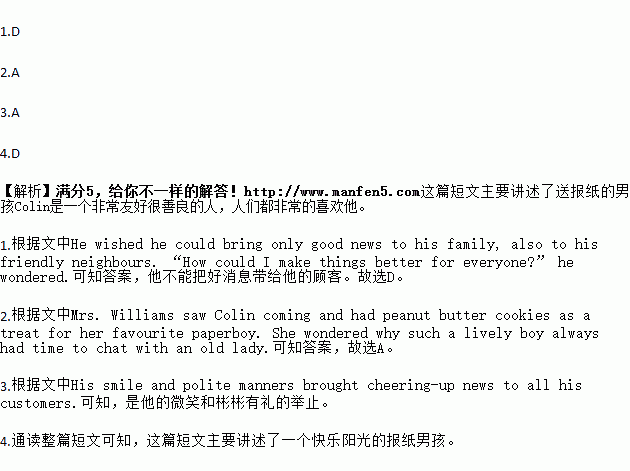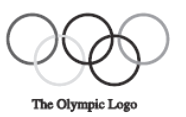题目内容
The wind tried pushing Colin to the ground. It felt as if Colin’s news-bag was full of potatoes.
Maybe it had to do with the news Dad read before Colin left. The morning headlines(标题)were full of the usual sad stories.
“No good news again!” Dad said.
Car accidents! House burns! Storm damage(损害)!
Colin moved quickly from house to house leaving papers in the mailbox. He wished he could bring only good news to his family, also to his friendly neighbours. “How could I make things better for everyone?” he wondered.
Colin noticed Alice coming. She only had one real eye. The other was made of glass. He liked Alice even if many others laughed at her. He didn’t realize how much it helped her, having a friend like Colin.
Each time Colin left a paper by a customer’s door, he thought, “How could I make some good news?”
Colin gave his usual cheerful “Hi” to everyone on his way. His smile was like the rising sun.
Someone was crying and he ran to where a little boy had fallen and hurt his leg. Colin calmed him down until the boy’s mother arrived.
“I’m glad you’re my paperboy,” she told Colin.
He continued on his way, but he didn’t feel tired. It was fun doing what he usually did—helping others.
He raced up the street to his last customer. Mrs. Williams saw Colin coming and had peanut butter cookies as a treat for her favourite paperboy. She wondered why such a lively boy always had time to chat with an old lady.
Colin’s own treat for his customers came from his heart. He did have much good news to share, even if he didn’t realize it. His smile and polite manners brought cheering-up news to all his customers.
1.What was Colin’s trouble?
A. His news-bag was too heavy.
B. He had heard of many sad stories.
C. His dad didn’t like his job as a paperboy.
D. He couldn’t bring good news to his customers.
2.Why did Mrs. Williams think Colin was her favourite boy?
A. Because he would always like to chat with her.
B. Because he liked her peanut butter cookies.
C. Because he didn’t bring bad news to her.
D. Because he always sent papers to her as fast as he could.
3.What was Colin’s treat for his customers?
A. His smile and polite manners. B. His papers full of good news.
C. His honesty and happiness. D. His confidence and friendship.
4.What’s the best title of this passage?
A. No news is good news
B. How paperboys work
C. The boring job as a paperboy
D. A sunny paperboy
Do you hate dirty beaches? We can’t pay you, but here is a chance to meet other volunteers and have fun. We need people who are strong and can help clean up Blue Water Beach. We don’t want to put off this job until summer. We need your help to collect and carry garbage. If you are available for six hours on Saturday, call Mr. Want at 558-6660. | Are you interested in repairing things? We have set up a group, Home Love, to help old people who need to fix up their homes. If you have repair skills, join us for eight hours a month. You can learn more about house building and get experience and training. Call Home Love at 555-4663. |
EFSL Club is looking for native speakers of English to join in an experiment. This experiment is carried out over the Internet. You don’t need any specific knowledge other than understanding and speaking English at a native level. The first task will take you around 15 minutes. After this task, you can decide whether you want to continue the experiment. The tasks involve reading texts and designing questions and answers. If you are willing to help, then please email us: club3864@hotmail.com | Are you good at working with children? We need two persons to volunteer at Sunshine Children’s Hospital. You need to be friendly and optimistic — the children are sick and you need to make them happy. Your job is to set up a play group for the children with funny games that you can play in their rooms. If you can spare an hour three times a week, come and join us! It’s a great chance to learn about hospitals and teaching. Email us: sunshinech@sina.com |
1.If you want to be a volunteer _________, you need to work six hours on Saturday.
A.in the EFSL Club B.at Sunshine Children’s Hospital
C.on the Blue Water Beach D.of Home Love
2.If you have repair skills and want to learn more about it, you can _________.
A.email to club3864@hotmail.com B.email to sunshinech@sina.com
C.call Mr. Wang at 558-6660 D.call Home Love at 555-4663
3.EFSL Club needs people who _________ to join in the experiment.
A.have some specific knowledge B.understand and speak English very well
C.are good at doing experiments D.can read and design questions and answers
4.Which of the following is not suitable for the children at Sunshine Children’s Hospital?
A.Paper cuttings. B.Flying kites. C.Singing. D.Drawing.
5.The underlined word “optimistic” means _________.
A.successful B.helpful C.thoughtful D.cheerful
6.We can probably read the material above on the _________ page of a newspaper.
A.advertisement B.entertainment C.fashion D.business


